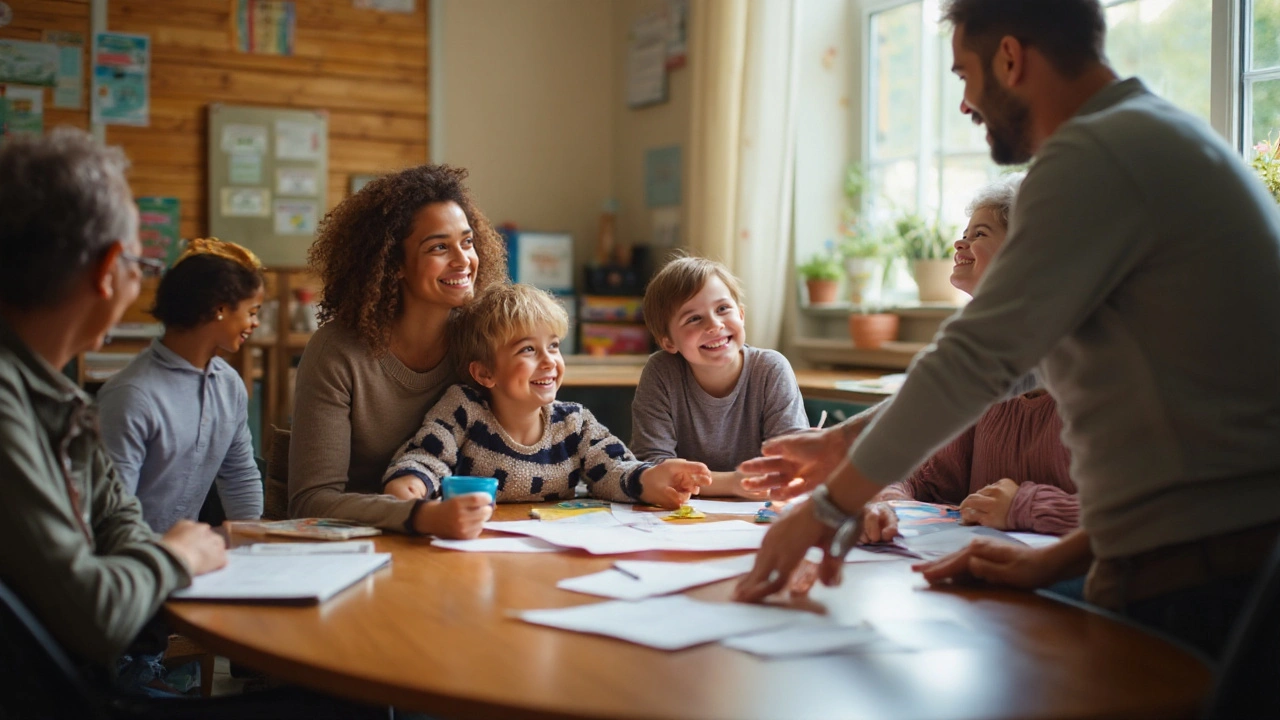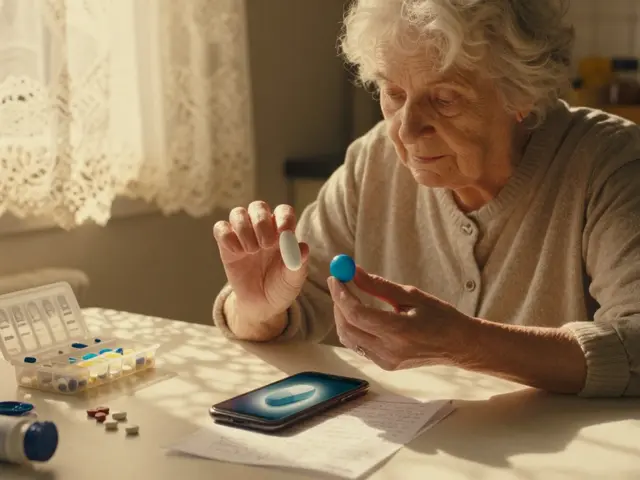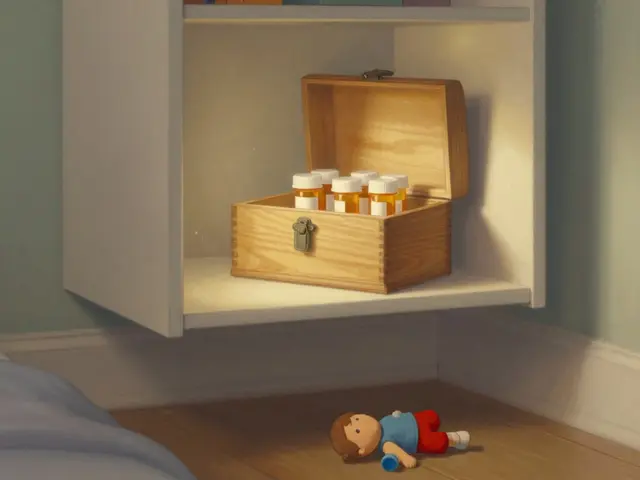Cerebral Palsy is a group of permanent movement and posture disorders caused by non‑progressive brain injury before, during, or shortly after birth. It affects about 2 to 3 per 1,000 live births worldwide and brings a mix of physical, communication, and sometimes cognitive challenges.
When a child is diagnosed, the whole family steps into an uncertain world. Medical appointments, therapy schedules, and school accommodations quickly become the new norm. That's where cerebral palsy support groups step in - they turn isolation into community, confusion into information, and stress into shared strength.
What Exactly Is a Support Group?
Support Group is a structured gathering of individuals who share a common experience or challenge, offering mutual emotional, informational, and practical assistance. In the cerebral palsy context, the primary participants are families - especially parents - who navigate the day‑to‑day realities of the condition. Groups can be led by a professional (e.g., a social worker), a trained peer mentor, or operate as a peer‑run circle with no formal facilitator.
Types of Support Networks
| Format | Meeting Frequency | Access Mode | Core Services |
|---|---|---|---|
| Local In‑Person | Monthly | Community center or hospital | Face‑to‑face sharing, guest speakers, resource handouts |
| Online Forum | Continuous (as‑needed) | Web‑based platform (e.g., CP Families Forum) | Threaded discussions, file sharing, live webinars |
| Parent‑Led Cohort | Bi‑weekly | Home‑based or virtual | Peer mentorship, advocacy training, budgeting tips |
| Professional‑Facilitated | Weekly | Clinic or telehealth | Therapy insights, mental‑health counseling, legal guidance |
Each format addresses a different need. Families in remote areas often rely on online forums, while those who thrive on personal connection prefer local in‑person meetings.
Why Families Turn to Support Groups
- Emotional safety: Sharing stories with people who truly get it reduces anxiety and depression.
- Practical knowledge: Learning about equipment, therapy techniques, and school rights saves countless hours of research.
- Advocacy power: United families can influence policy, lobby for better insurance coverage, and push for inclusive school programs.
- Resource pooling: Group members often trade or co‑rent expensive assistive devices.
Key Players in the Support Ecosystem
Beyond the informal gatherings, several organized entities amplify the impact.
Parent Advocacy Network is a collective of parents who coordinate lobbying, information campaigns, and legal assistance for families affected by cerebral palsy. In Canada, the Canadian Cerebral Palsy Parents Association (CCPPA) is a leading example, providing policy briefings and a national database of specialists.
Nonprofit Organization is a registered charitable group that delivers services, funds research, and raises public awareness about cerebral palsy. United Cerebral Palsy (UCP) and the Cerebral Palsy Foundation (U.S.) often collaborate with Canadian chapters to secure grants for mobility equipment and to fund community‑based recreation programs.
Online Forum is a digital platform where families post questions, share experiences, and access moderated resources around the clock. The CP Families Forum, launched in 2015, now hosts over 9,000 registered members, with active threads on everything from insurance appeals to home‑installed ramps.
Respite Care Service is a short‑term, qualified caregiving support that gives primary caregivers a break from daily responsibilities. Many health‑authority programs subsidize up to 20 hours per month, reducing caregiver burnout and improving family cohesion.
Financial Assistance Program is a government or charitable fund that helps families cover the high cost of medical equipment, therapy, and adaptive home modifications. In Ontario, the Assistive Devices Program (ADP) and the Ontario Disability Support Program (ODSP) together provide up to $15,000 per child for approved devices.
Family is a unit of parents, siblings, and extended relatives who share responsibilities, emotions, and decisions surrounding a child with cerebral palsy. The health of the whole family influences the child’s progress, making comprehensive support essential.

How to Find and Join a Group
- Start with your child’s clinic or hospital social worker - they often keep a directory of local groups.
- Visit national nonprofit websites (UCP, CCPPA) for a searchable map of meetings.
- Search online forums using keywords like "cerebral palsy parent support" and request an invitation.
- Ask your pediatric therapist if they recommend a peer‑mentor program; many run quarterly meet‑ups.
- Consider hybrid participation - attend a monthly in‑person session and complement it with daily online chats.
Most groups have a trial period; feel free to attend a couple of meetings before committing.
Common Barriers and How to Overcome Them
- Travel distance: Leverage video‑conference tools; many groups now broadcast meetings on Zoom.
- Time constraints: Choose a parent‑led cohort that meets early evenings or weekends.
- Language or cultural differences: Look for multicultural chapters or request translation services - many nonprofits offer bilingual facilitators.
- Feeling of not fitting in: Remember that each group is a collection of unique stories; try a different format if the first doesn’t click.
Related Topics and Next Steps
Support groups sit within a larger knowledge cluster that includes:
- Therapeutic interventions - physiotherapy, occupational therapy, speech therapy.
- Educational rights - Individual Education Plans (IEPs) and inclusive classroom strategies.
- Assistive technology - powered wheelchairs, communication devices, home modifications.
After joining a group, families often explore deeper resources like specialized rehabilitation centers or advocacy training workshops. Future articles could dive into "How to Navigate Insurance for Cerebral Palsy Equipment" or "Designing an Inclusive Home for Mobility Challenges".
Frequently Asked Questions
What age groups can join cerebral palsy support groups?
Most groups welcome parents of children from infancy through adolescence. Some adult‑focused circles exist for teens and grown‑up members who want peer support after transitioning out of pediatric care.
Are support groups free?
In‑person meetings are typically free or covered by hospital budgets. Online forums may charge a nominal membership fee to cover hosting costs, but many are completely free thanks to nonprofit sponsorship.
How do support groups help with school advocacy?
Parents share successful IEP templates, legal precedents, and contacts for educational consultants. Collective lobbying has led several school boards to adopt universal design principles, easing classroom integration.
Can I start my own support group?
Absolutely. Begin by identifying a meeting space (library, community centre), set a regular schedule, and invite a few trusted families. Use existing nonprofit resources for flyers and facilitator training.
What role do professional facilitators play?
Social workers or psychologists can guide discussions, ensure confidentiality, and introduce coping‑skill workshops. Their presence often attracts families who need structured emotional support.
How can I access respite care through a support network?
Many parent‑led networks maintain a vetted list of certified respite providers. By sharing contact info, members can secure discounted or subsidized hours and arrange backups when regular caregivers are unavailable.
Do support groups address financial concerns?
Yes. Groups often host budgeting workshops, share grant application tips, and connect families with financial assistance programs like ADP or charitable foundations that sponsor equipment purchases.






Comments
Steven Young
22 September 2025Most so‑called support groups are just a front for hidden agendas. They profit from your grief while pretending to help.
Kelly Brammer
26 September 2025While you speculate about motives, the reality is that many families genuinely benefit from shared resources and emotional support. The community aspect can ease the isolation that often accompanies a CP diagnosis.
Ben Collins
1 October 2025Yeah, because a monthly coffee meetup totally cures motor spasticity.
Denver Bright
5 October 2025I get that you think these groups are just chatter, but many parents tell me they’ve found real‑world tips that actually save them money. It’s not all fluff.
Kelli Benedik
10 October 2025Honestly, I can’t help but feel a rush of emotions when I hear stories from families who finally found a place where they belong.
It’s like stepping into a room where everyone knows the exact phrase you need to hear after a tough day.
Support groups give parents a vault of practical hacks – from how to secure a wheelchair on a bus to navigating school IEP paperwork without losing your mind.
They also hand out the emotional blankets that keep you warm when the night feels endless.
Seeing a fellow parent share a breakthrough, like a new therapy technique that actually improves hand coordination, can reignite hope.
Those moments become the glue that stitches together a community that might otherwise feel scattered.
Even the smallest gestures – a homemade snack for a therapy session or a quick phone call reminding you of your child’s strengths – ripple out into big changes.
And let’s not forget the advocacy power that grows when families band together; they can push for better insurance coverage or lobby for accessible playgrounds.
When you’re stuck in a maze of paperwork, having a group that’s already mapped the route is priceless.
There’s also the comfort of knowing you’re not the only one battling bureaucracy.
Some groups even pool expensive equipment, letting a family rent a standing frame they couldn’t otherwise afford.
That kind of resource‑sharing can mean the difference between a stagnant routine and a dynamic, engaging day for the child.
Emotionally, the shared laughter over the chaos of therapy appointments lightens the load.
When a parent admits they’re exhausted, the group responds with empathy, not judgment, and often a funny meme that says it all.
All of this builds resilience, which is essential for long‑term well‑being.
In the end, these circles become a lifeline, a place where you can breathe, learn, and grow together.
cariletta jones
15 October 2025Finding a community that truly understands your journey can make a world of difference. It also opens doors to resources you might never discover on your own.
Kevin Hylant
19 October 2025What specific resources do local hospitals usually share with new parents? Are there any quick‑start guides that help families avoid the steep learning curve?
Holly Green
24 October 2025The facts speak for themselves; support groups are an essential part of comprehensive care.
Craig E
29 October 2025It is a rare blessing to encounter a gathering where empathy flows as freely as conversation. In such circles, the collective wisdom becomes a lantern lighting the darkest corridors of uncertainty. The shared narratives weave a tapestry of resilience, reminding each soul that they are not solitary travelers. When we listen, we also learn the subtle art of advocacy, turning personal stories into powerful petitions for change. Ultimately, these meetings nurture both heart and mind, forging bonds that outlast any single challenge.
Marrisa Moccasin
2 November 2025Wow, the depth of these groups is astonishing, isn’t it?! They’re not just casual meet‑ups, they’re lifelines, they’re vaults of information, they’re advocacy engines!!! If you ever doubt their value-look at the legislation they’ve helped pass, the equipment they’ve pooled, the emotional bridges they’ve built!!!
Caleb Clark
7 November 2025Support groups are like a toolbox that keeps geting added to, every meetign you learn a new tool. I remember the first time I went to one and felt totally lost, but then a veteran parent showed me how to fill out the insurance claim form correctly. That alone saved us a few thousand dollars! Also, there are loacal meetups where therapists give quick demos-watching a physio show a simple stretching routine was a game‑changer for my kid. The emotional boost is real too; hearing other parents say “I get it” feels like a warm blanket on a cold night. Even the kids benefit, they see other families and feel less alone. Lastly, the group often shares contacts for reputable equipment vendors, which keeps you from getting scammed. All in all, each session adds a layer of confidence. Ont he whole, it's a community that lifts you up, no matter how tough the day gets.
Eileen Peck
11 November 2025I've seen families transform after just a few weeks of consistent meetups. They start to share tips, like how to adjust a wheelchair seat for comfort, and suddenly the daily routine feels smoother. The empathy in these groups is genuine, and even though I sometimes typo my posts, folks never judge. It’s a safe place to vent, celebrate wins, and get advice without feeling like you’re bothering a professional. The knowledge exchange is priceless: from navigating school IEPs to finding affordable therapy options. This exchange can dramatically reduce stress levels.
Oliver Johnson
16 November 2025Our nation should prioritize traditional medicine, not these modern support collectives. They're a distraction from real progress.
Taylor Haven
21 November 2025While you champion old‑school approaches, the truth is that families today need more than just pills and prescriptions. Support groups provide the human connection that no government program can replicate. They teach parents how to advocate for their kids in schools, secure funding for adaptive equipment, and even navigate the maze of insurance claims. Ignoring this grassroots network is like refusing to see the forest for the trees. Moreover, these groups have successfully lobbied for policy changes that benefitted countless children. If we truly care about our nation's future, we must back these community‑driven initiatives. Otherwise, we risk leaving our most vulnerable citizens without a voice. The data shows lower stress levels and better outcomes where such groups are active. It's not about replacing medical care; it's about supplementing it with empathy and shared wisdom. So before dismissing them, consider the tangible benefits they bring to families across the country.
Sireesh Kumar
25 November 2025Let me tell you, the drama in these circles could rival any TV series. Parents spill everything-wins, failures, midnight meltdowns-while we all sit there, nodding like it’s a support séance. It’s oddly comforting, though, because the raw honesty cuts through the polished advice you see online. Every session feels like a rehearsal for the real world, where you have to fight for resources and dignity. In the end, the chaos builds a bond stronger than any formal program could offer.
Jonathan Harmeling
30 November 2025Honestly, the brilliance of these groups lies in the shared expertise that springs from lived experience. When faced with a new challenge, you’ll find someone who’s already navigated it and can hand you a concrete solution. It’s a reminder that collective knowledge often outpaces what any single professional can provide.
Ritik Chaurasia
5 December 2025Cultural exchange enriches every support circle.
Gary Marks
9 December 2025Alright, let’s get real about the emotional rollercoaster here. These meetings can feel like a lifeline when you’re drowning, but they also pull you into a vortex of stories you can’t escape. I’ve heard endless tales of triumph and tragedy, each one feeding the next in a never‑ending loop. When you’re drained, the flood of emotions from others can either lift you or drag you deeper. Still, the palpable camaraderie is addictive-once you’ve tasted that shared sorrow, you crave it in a twisted way. The energy in the room is electric, but it can also be overwhelming, like standing too close to a powerhouse. In the end, you’re left buzzing, both humbled and exhausted, craving another session even as you sense the drain. It’s a paradox that keeps us coming back, hungry for the next wave of shared experience.